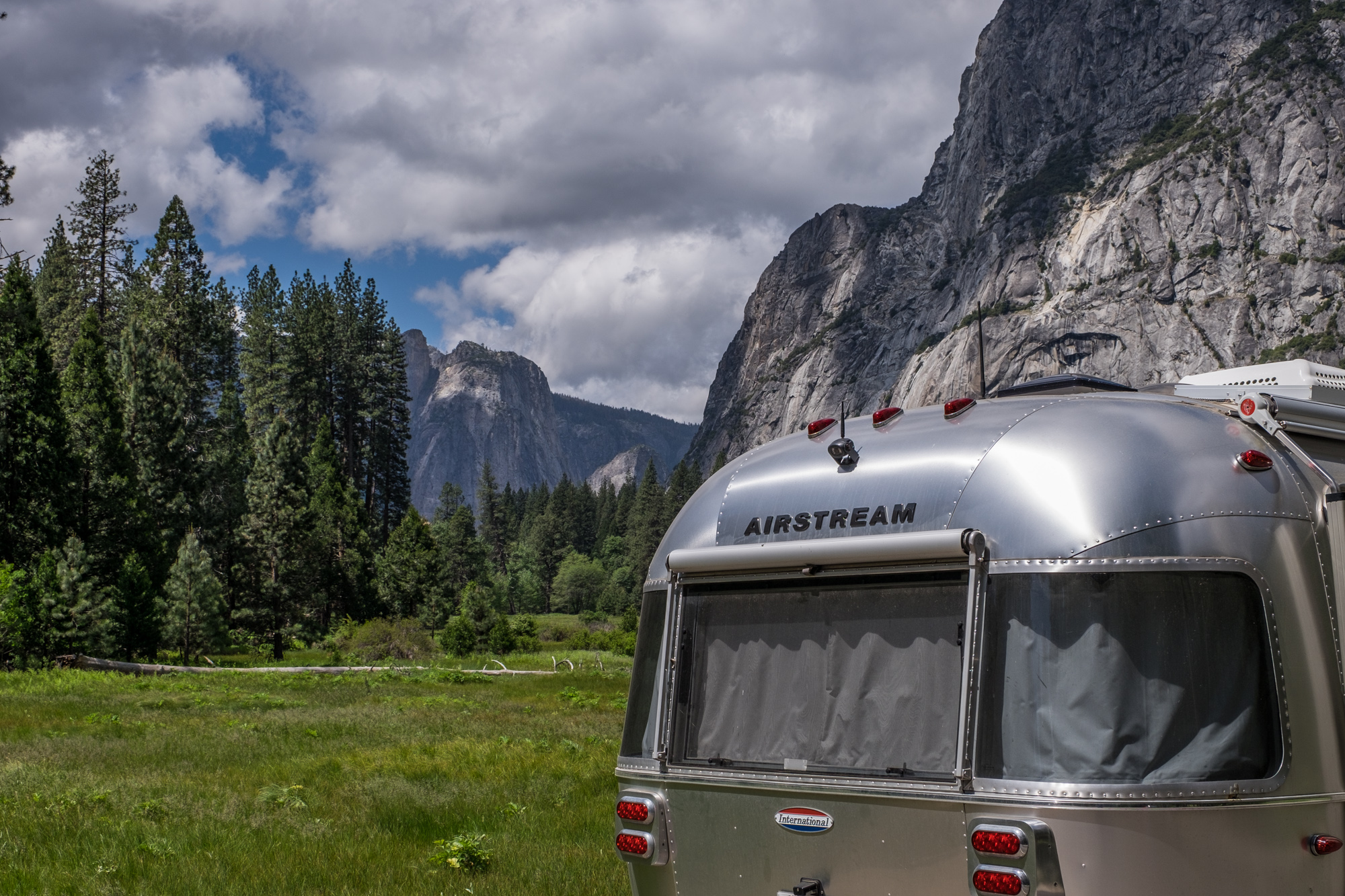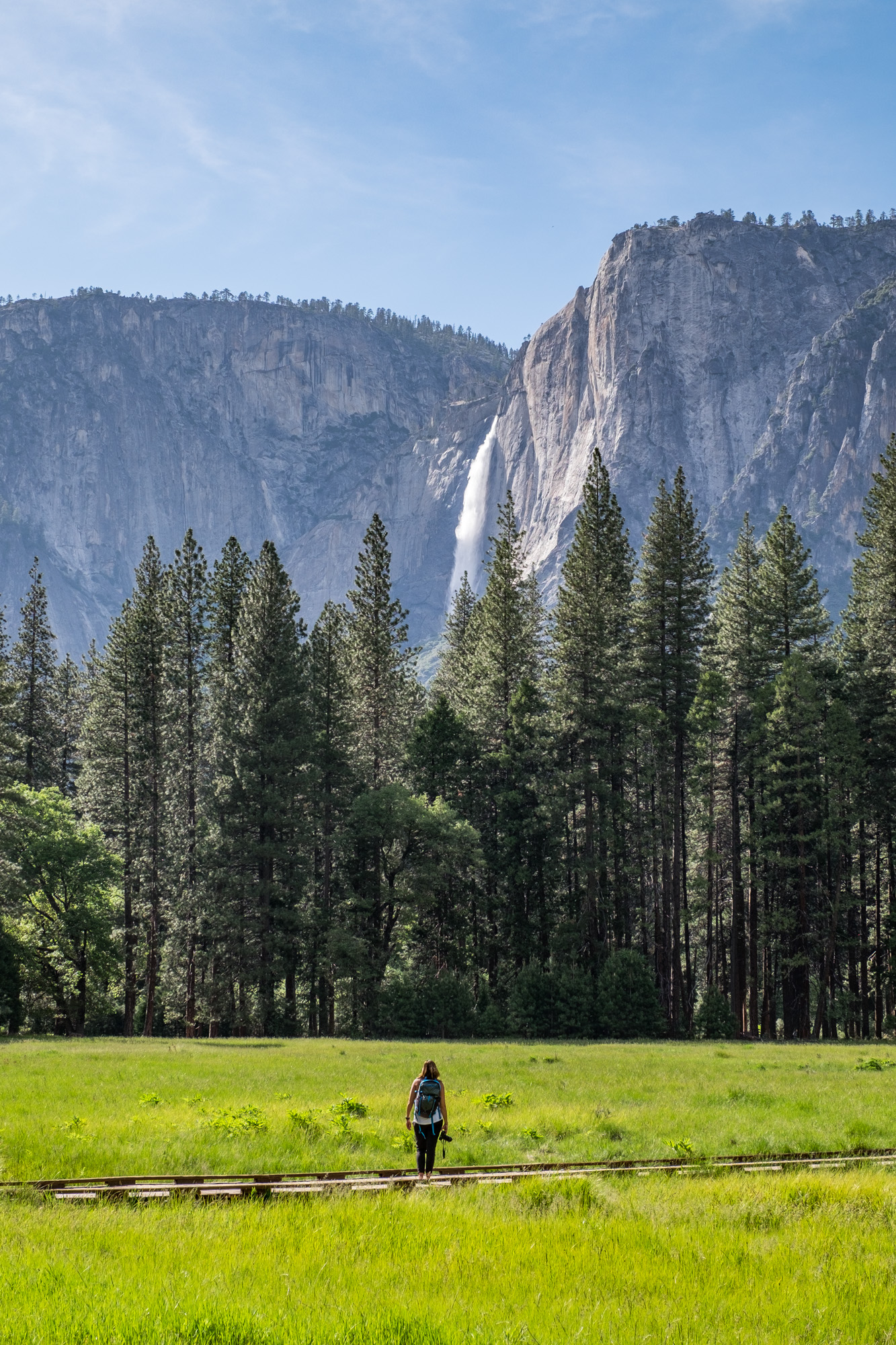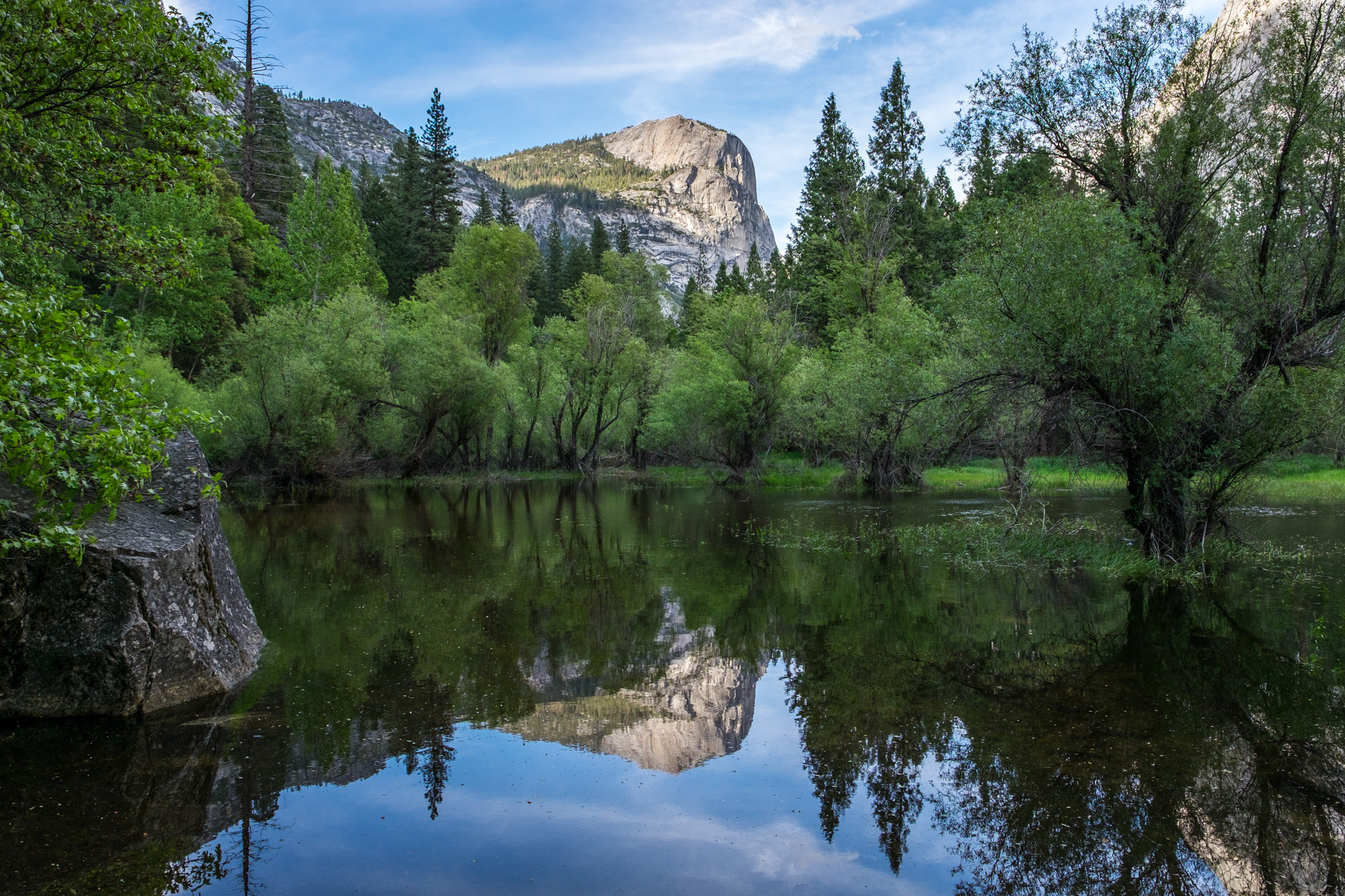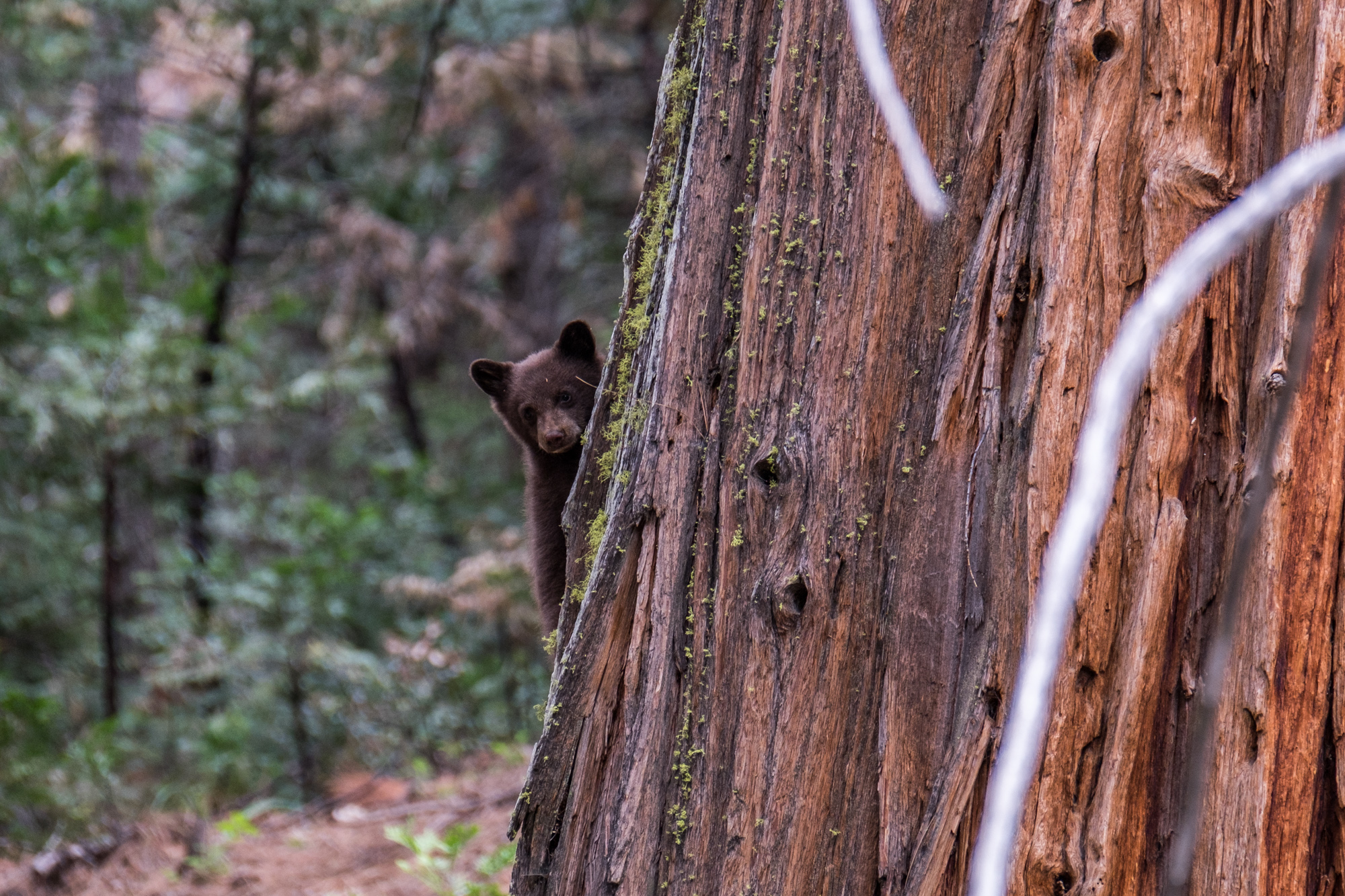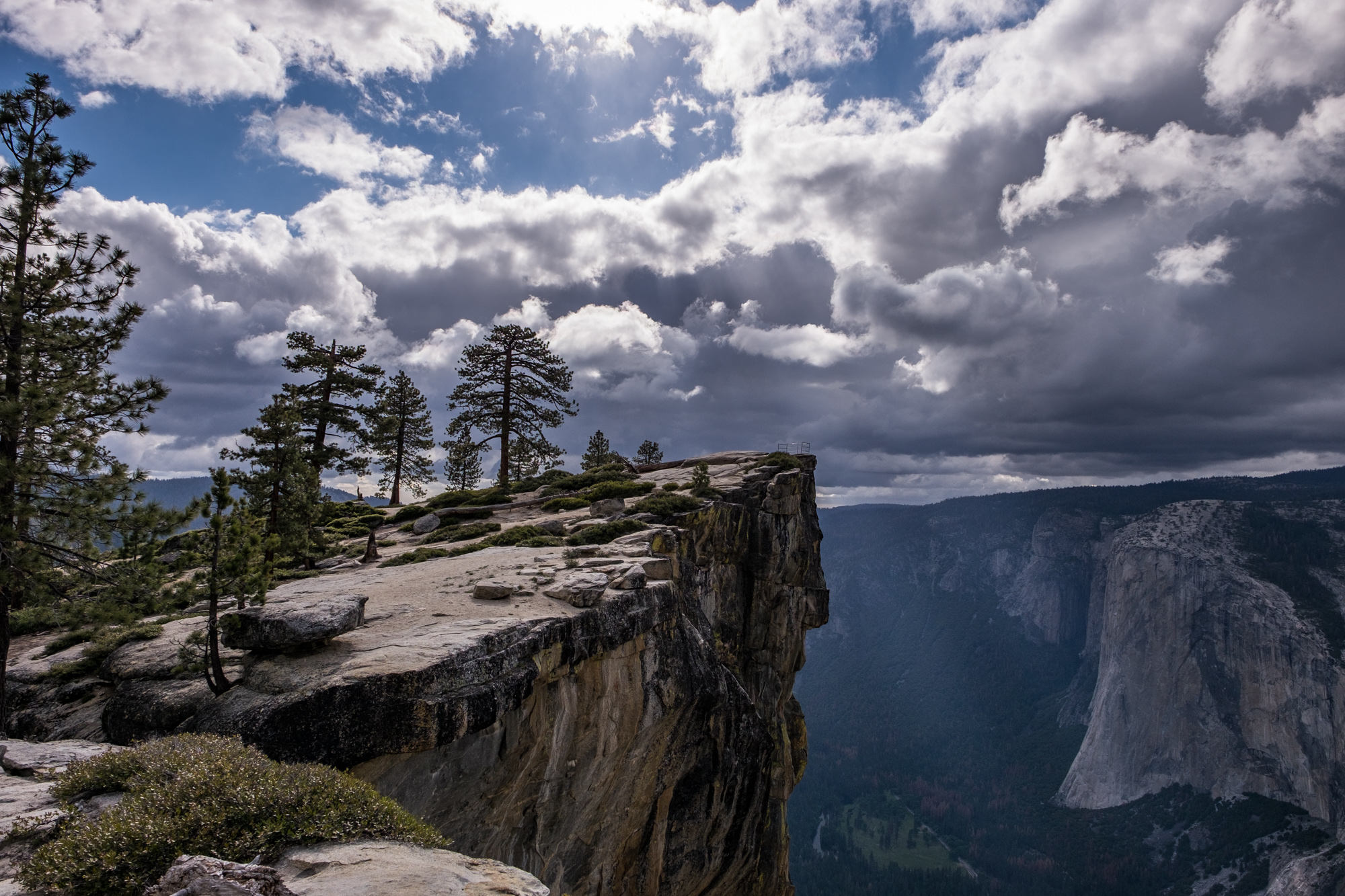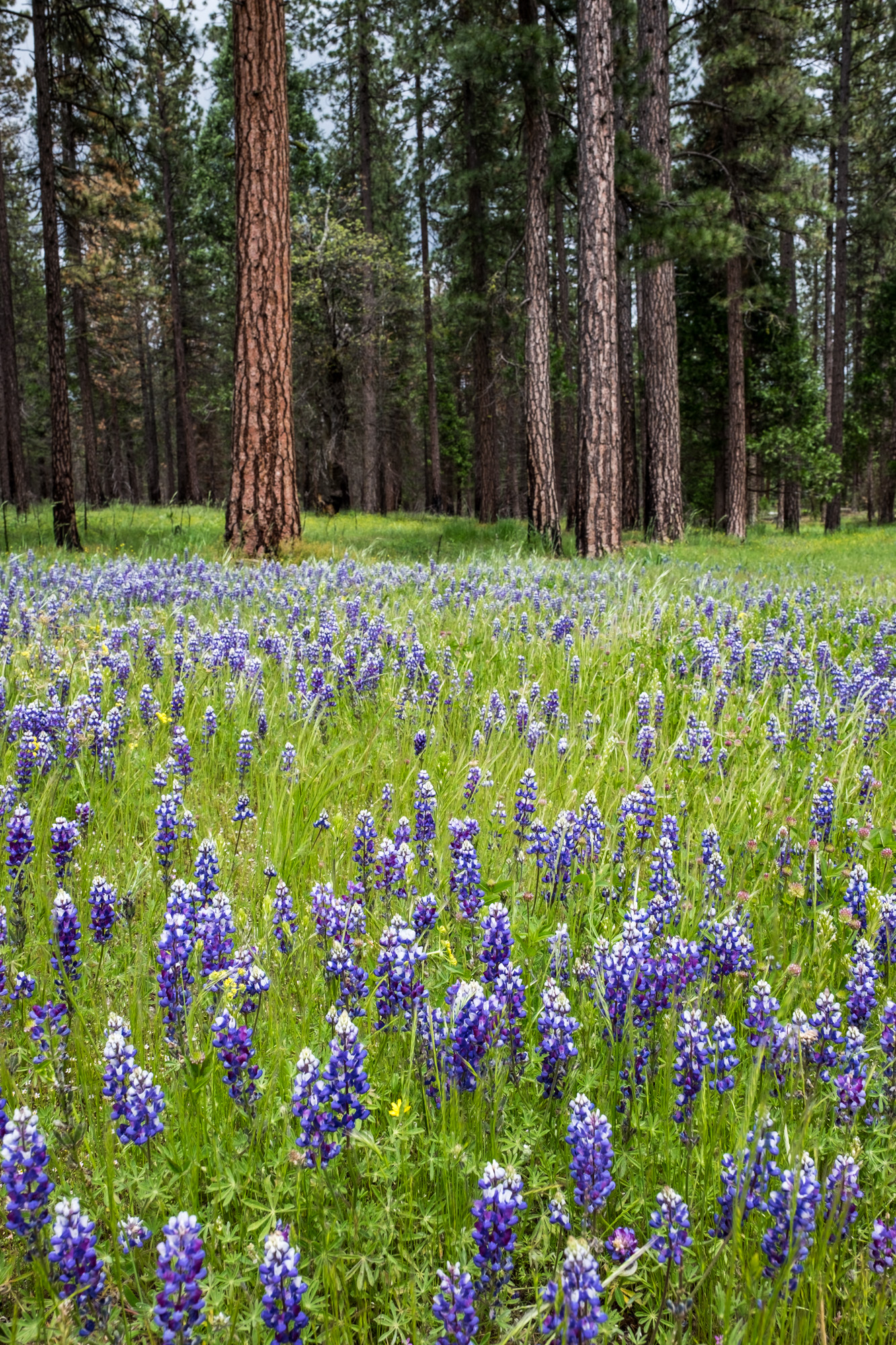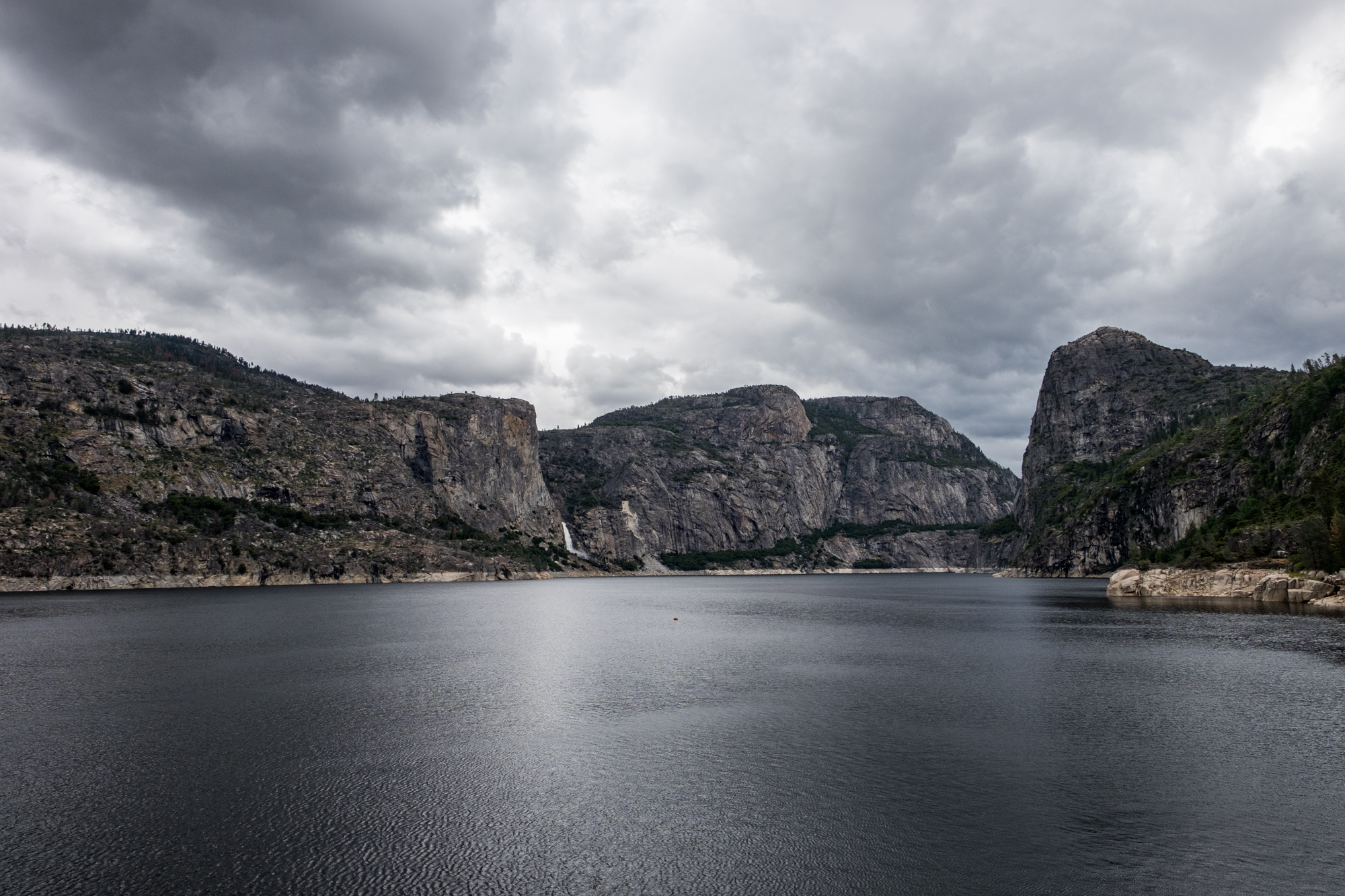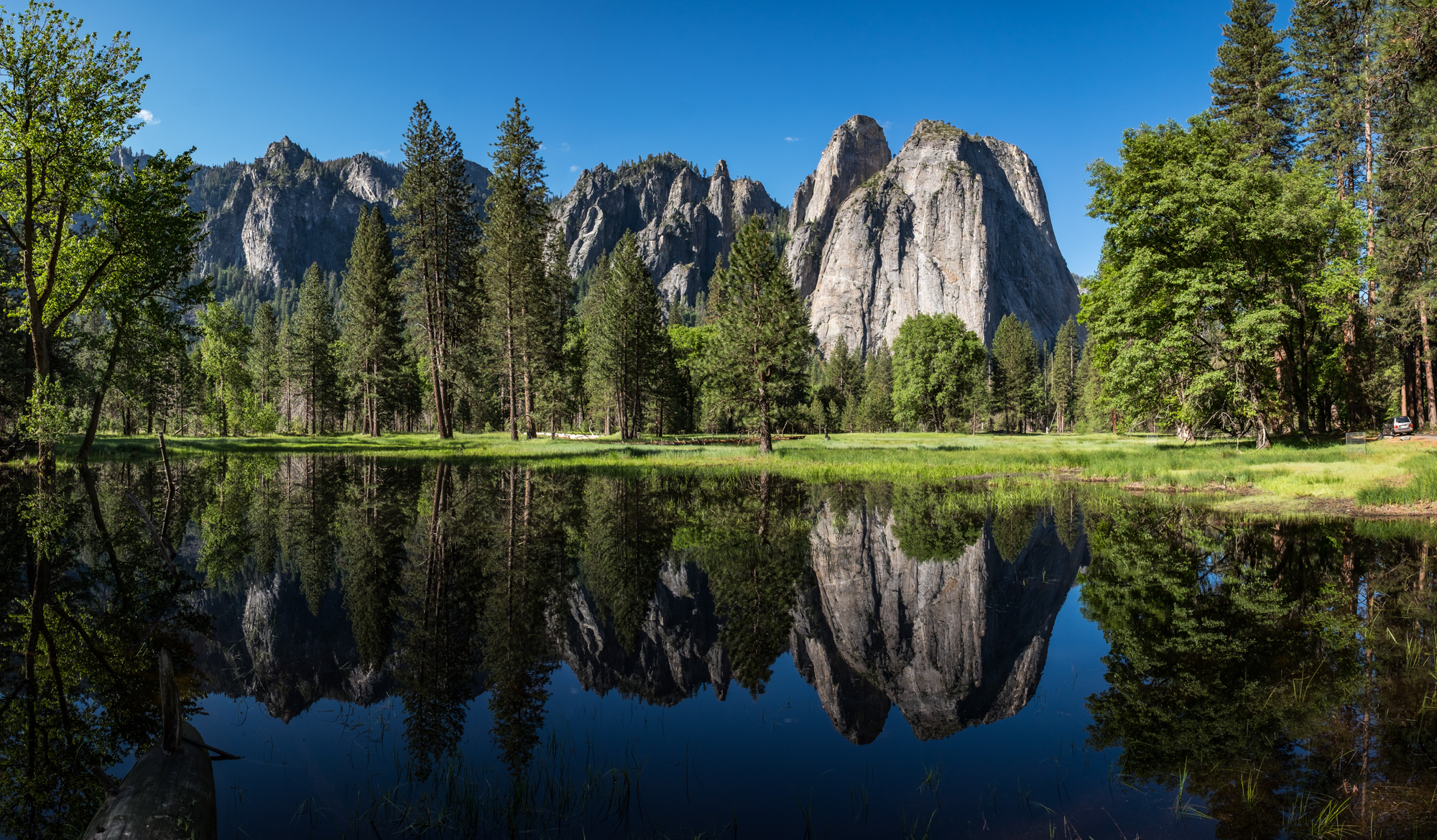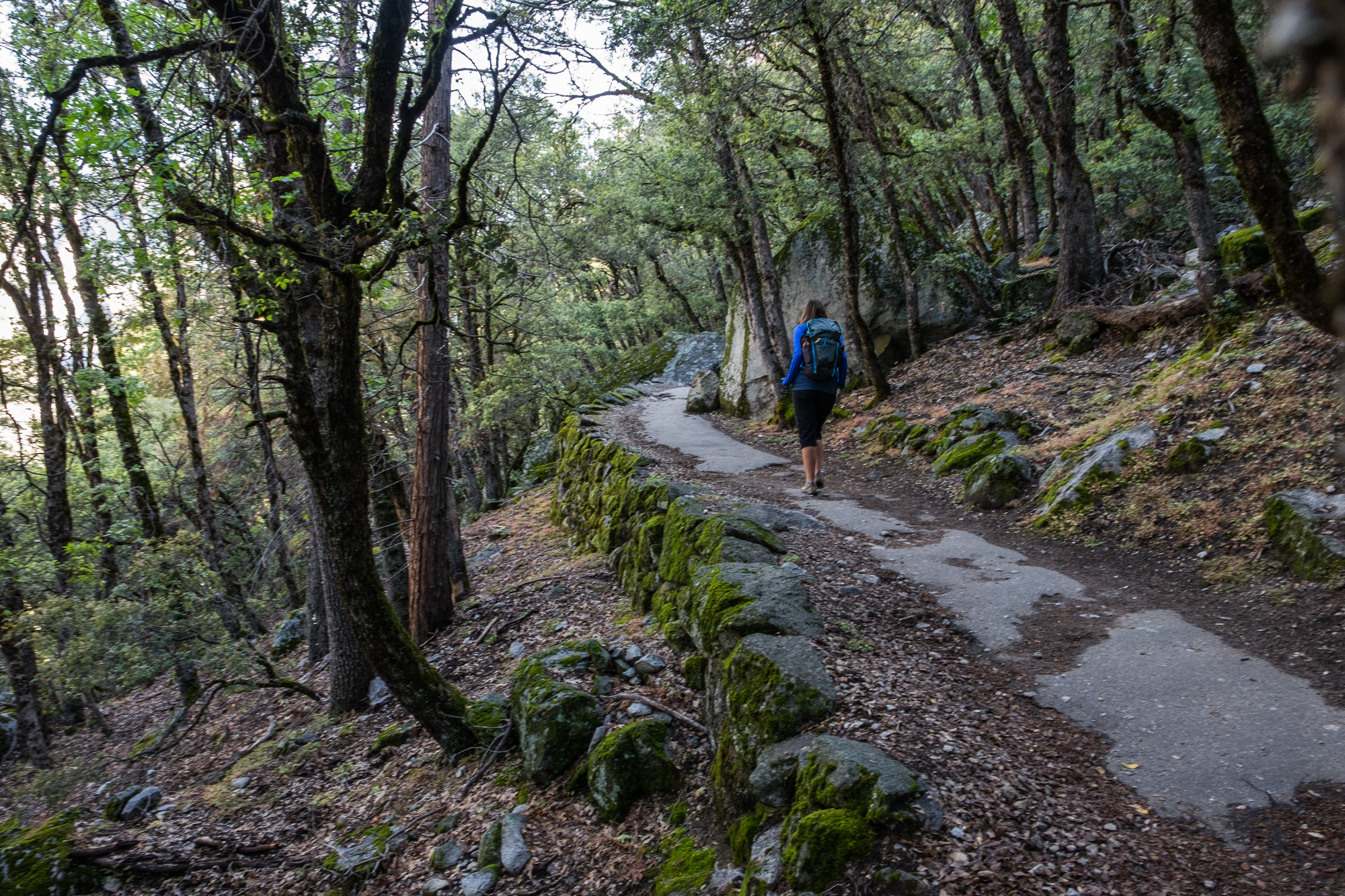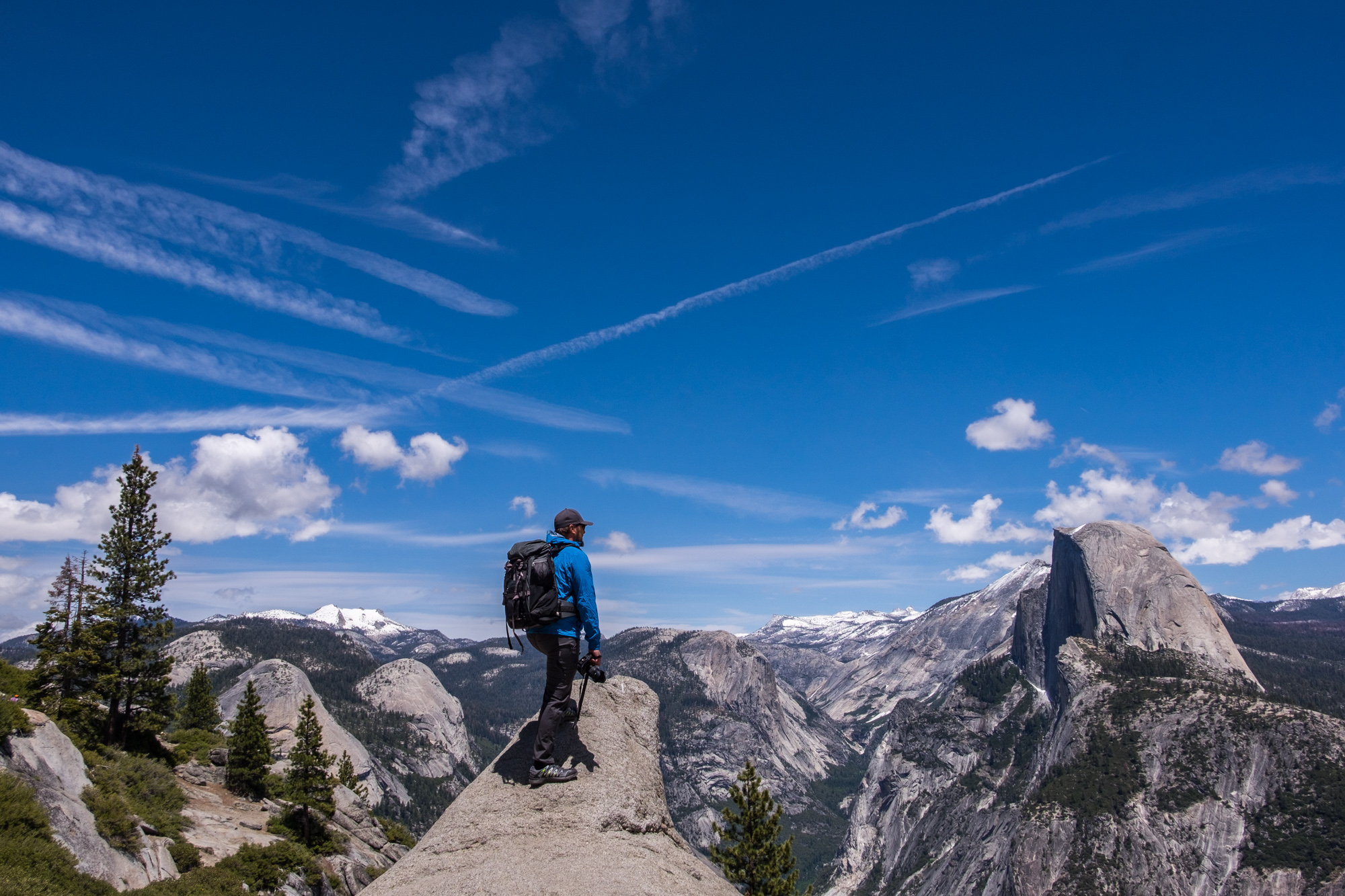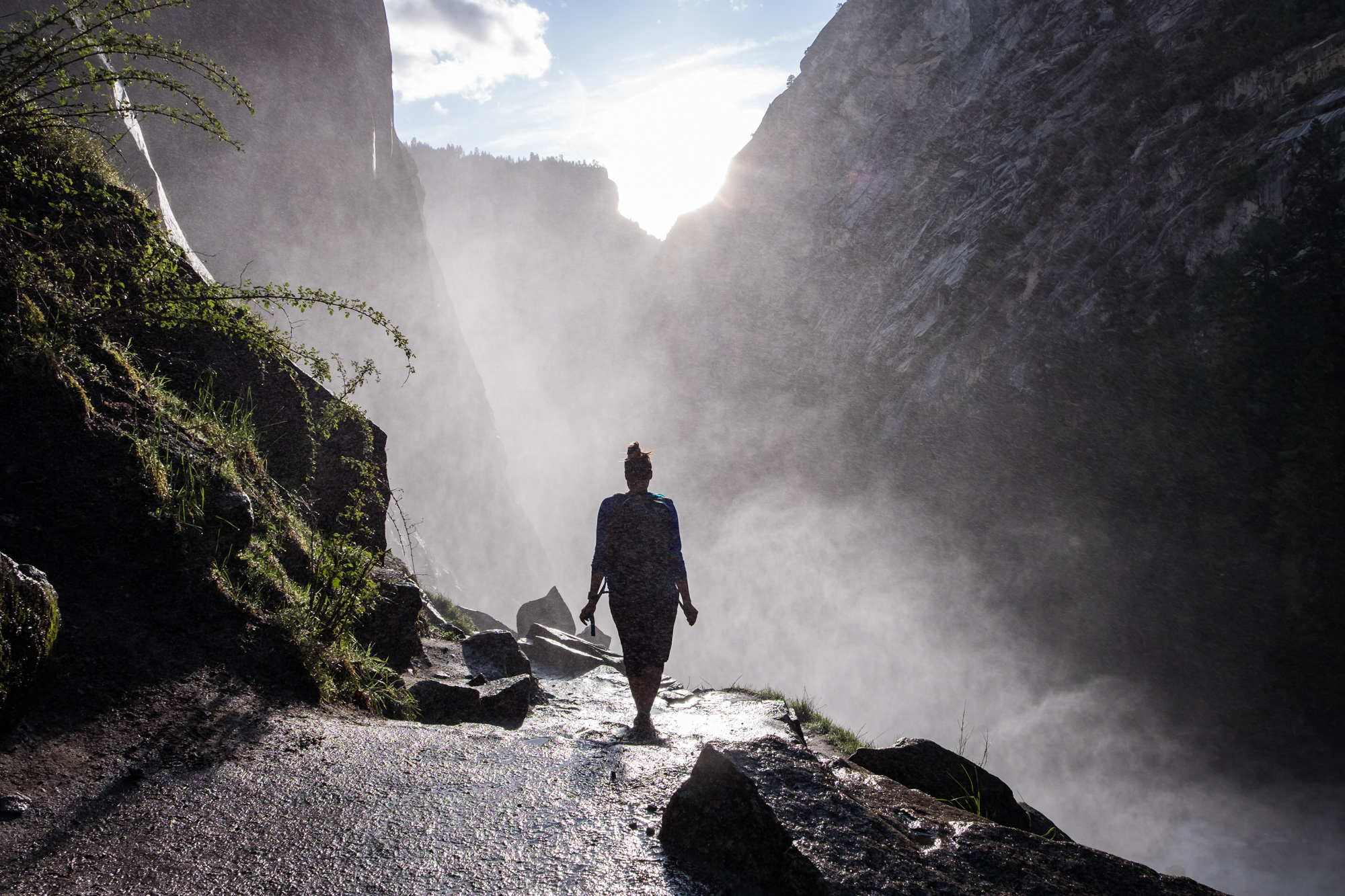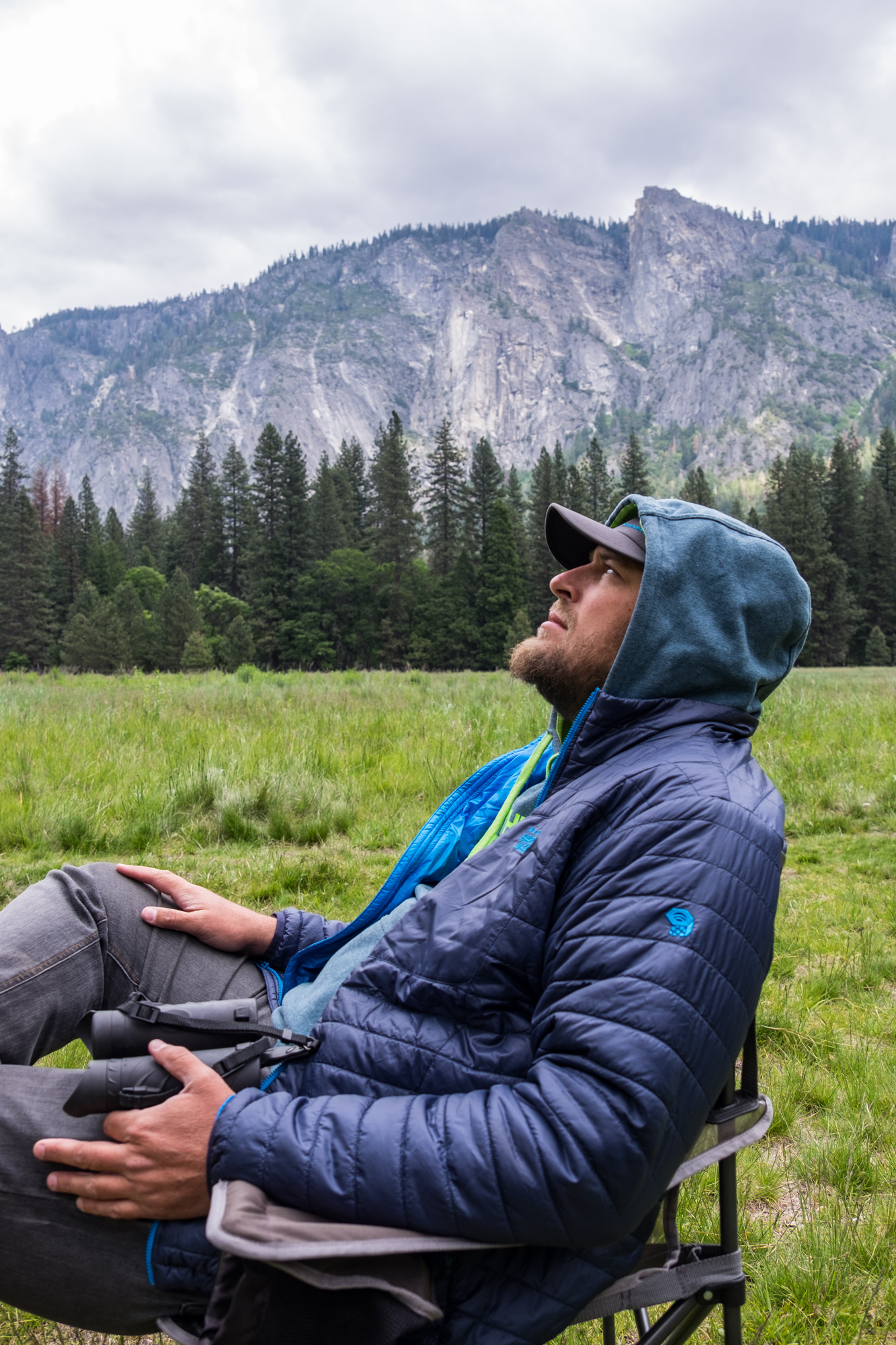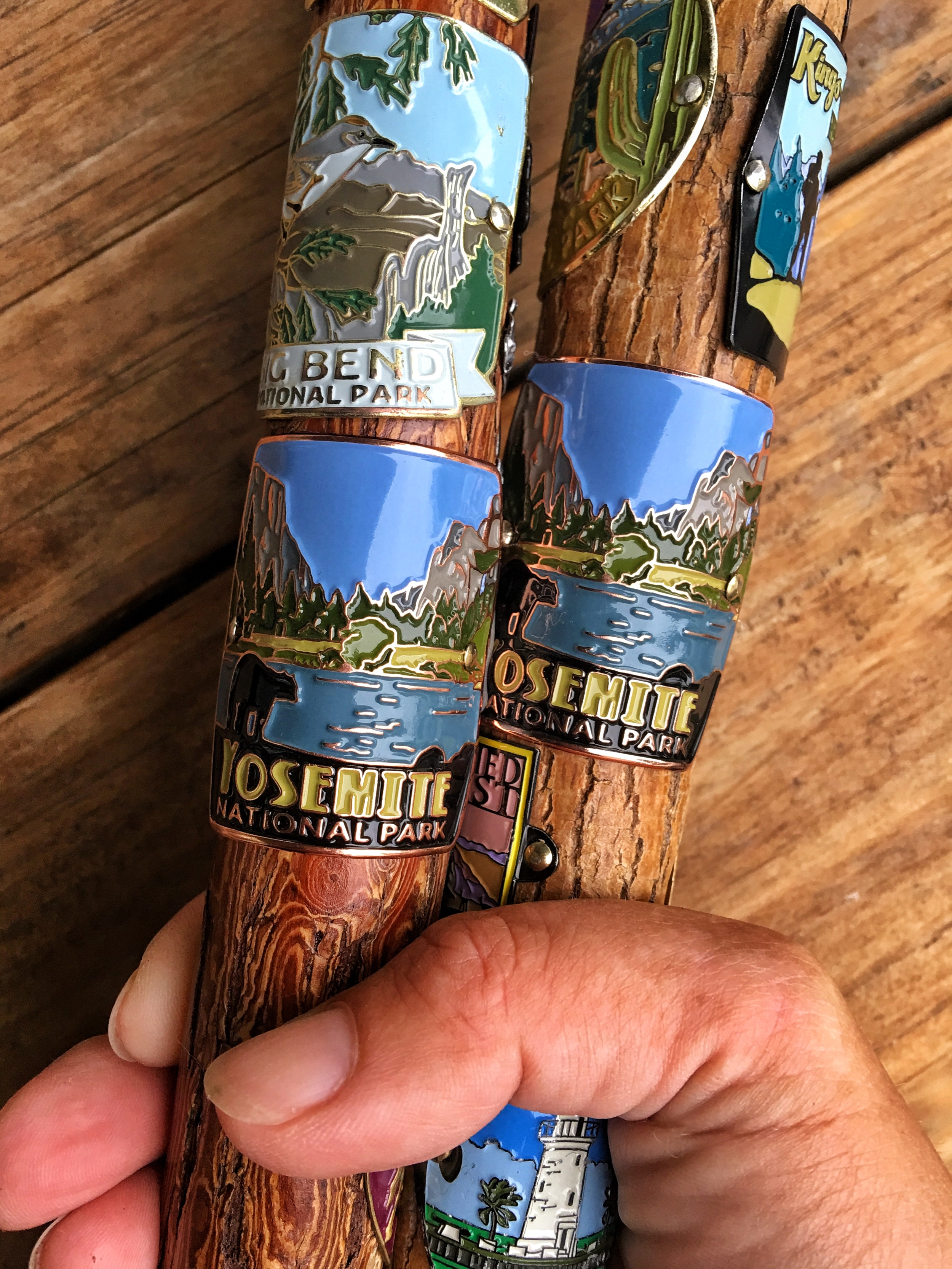Yosemite National Park, California, USA | 24/59
““It is by far the grandest of all the special temples of Nature I was ever permitted to enter.” ”
16 Iconic Sites in Yosemite National Park
Yosemite National Park has been touted by many to be among the most beautiful places in the world. In the world. That is a very tall measure! With such a claim it’s impossible not to ponder: 'how beautiful can it really be?' Driving into the valley we were eager for it to show itself, to reveal its unmatchable beauty, and it did—boom—just like that after exiting the Wawona Tunnel and perched upon Tunnel View there it was: the most beautiful place in the world.
It just might be. It's right up there, that's for sure. It would certainly be a challenge to determine a place more lovely than Yosemite is when judging it by the sum of its parts. Individually, they are melodies; together, they are a symphony. Case in point: the breathtaking vision as seen from Tunnel View...
Perfection at Tunnel View.
...humor me for a moment and try not to look at the scene in the picture above as a whole view, but instead have a look at each component of it. The frothy clouds that make way for blue sky but still hang on the horizon; depth of field that delight painters and photographers. The dramatic multi-hued granite rock formations infer how very hard (geologically speaking) those surfaces are, surfaces that when weathered by erosion split into expansive vertical cracks; an ideal place to build technical climbing routes that people come from all over the world take on. Blankets of trees laying on top of the rocks and covering the valley—pine, oak, cedar, fir—all serve a different purpose to the whole of the ecosystem and wildlife habitats that live there, while simultaneously enfolding the humans that wander between them (but which in this view we cannot see.) The shape of the valley that cradles the world living on top of it—it's almost as if you are looking into a snow globe. And punctuating the entire scene is that waterfall, Bridalveil Falls, cascading perfectly down while breathing life into the whole of the scene. This place couldn't have been dreamed up or drawn better—it is an overwhelming state of raw beauty.
With such visual enormity, Yosemite can be a daunting park to explore. Where do you start? From where can you take it all in? It certainly doesn't happen all in one place... In that spirit, we briefly outlined below most of the places we visited while there in May, including two others that we missed but would have visited had we been able to. It was by exploring these 16 places that we were able to take in Yosemite in a way that mesmerized us both to no end.
1. Tunnel View (pictured above) — This is without a doubt the most iconic viewpoint in the park. Ansel Adams captured it endlessly producing some of his most recognizable photographs while in turn popularizing the location. It was picturesque long before Adams ever laid eyes on it and it has been magically captured by many photographers since. Perched at the western entrance to the valley, just as you pass through the Wawona Tunnel, you will see it in all its glory. At any time of day there is some size of a crowd at the overlook waiting to get their view or shot of El Capitan, Half Dome, Sentinel Dome, spires of cliffs framing the evergreen meadow, and Bridalveil Falls —the 317-foot cascading waterfall that flows year round and streams down to the valley floor. No scene could ever be composed more perfectly proving yet again, that Mother Nature is the world's greatest artist.
2. Half Dome — This granite rock formation is among the most recognizable of its kind with one side boasting the sheerest cliff in North America (93% grade) and the other, sloping down in a perfect curve. Geologists once thought that the formation was a true dome that was split in half — leaving one standing while the other dissipated from erosion. Today it is more widely believed that the second half never actually existed. Either way, it is spectacular to view and to photograph from such locations as Tunnel View (bottom-up view) and Glacier Point (face-to-face view as shown below.) To hikers, this climb that was once declared an impossible fete for humans to conquer is now regarded to be one of the great hiking challenges of its kind. Learn more about this harrowing cable climb on the official National Park Service site for Half Dome hiking at Yosemite (and known your ability level before taking it on!)
Half Dome as seen from Glacier Point.
3. Glacier Point — This is the best place in the park to experience the Yosemite high-country while observing panoramic views of Half Dome, various distant waterfalls, and the whole of the valley floor — in other words, the best of Yosemite within one gaze. Glacier Pass Road takes you there by car, but do watch for closures that could cause you to reroute your plans, especially during shoulder season when ice renders the pass impassable. We faced this situation and lapped up the rare opportunity to experience an unusually desolate Glacier Point by hiking to it on the Four Mile Trail (see next section.) The viewpoint is equally remarkable when open to all. With two sizable lookouts, there is plenty of view-space to go around and with many others to view it with, you can dice up your photos by incorporating people after you get the shot that you first thought you came for.
4. Four Mile Trail — Appropriately named, this 4-mile+ trail is a steep hike ascending 3,200 hundred feet. That's a lot of gain. It is commonly traveled as an out-and-back hike; as a one-way hike with a shuttle ride back from the top or bottom; or adjoined with the rightfully popular Panorama Trail that starts at Glacier Point leading back down to the valley floor (that was our route.) What was so awesome about Four Mile Trail is the unique views you are able to see as you reach different levels of elevation. The terrain follows a well-beaten path (it was built in 1872) with lush flowers and vegetation on either side the whole way up. This is a tough, rewarding, and gorgeous way to and from the lookout at Glacier Point.
A view of unmatched beauty as seen from Panorama Trail.
5. Panorama Trail — This is one of the most popular hikes in all of Yosemite — so popular that it was hiked by POTUS, FLOTUS, and their daughters during the First Family's visit to Yosemite in June. Starting at Glacier Point you will meander around the perimeter of the valley walls crossing a rugged but well-beaten trail from the high-country all the way to the basin while taking in panoramic views of the Yosemite Valley the entire way. Walking along a portion of the John Muir Trail, (stretching all the way to Sequoia and Kings Canyon,) you will see distant views of Vernal Falls and Nevada Falls until you find yourself among them. This 8.5-mile (one way) hike is often done on its own with auto transportation at the trails end. We paired it with the Four Mile Trail which together turned out to be pretty much one of the best and most rewarding day hikes either of us has ever experienced.
A climber makes his peace on the nose of El Cap.
6. El Capitan — Who knew that a 3,000-foot boulder could cause so much heartbreak and joy? El Capitan is an enormous granite monolith sitting on the north side of the Yosemite Valley. It stands statuesque above the valley floor for onlookers to ogle from Tunnel View, Bridalveil Falls, and El Capitan Meadow; and as a place for experienced climbers to summit. It was 'El Cap' (as it is known to locals and climbers) that inspired the sport of rock climbing in its modern form during the mid-20th century. We felt that El Cap and the climbing culture at Yosemite deserved a separate write-up, so we did a small outpost on that near the bottom of this page. As for viewing El Capitan solely for its geological beauty, enjoy and don't forget your binoculars—tiny humans riding an enormous exposed cliff is always worth a look.
A beautiful rainbow greets us at Vernal Falls. Later that same day: the Yosemite Moonbow.
7. Vernal Falls — It was at Vernal Falls that we had the chance to see rock climbers repelling from the top down more than 300 feet to the valley floor. We also caught a quick rainbow, you know, for good measure. Viewing areas at the top of the falls are split into two on either side of the falls and are joined by a bridge crossing over the thrashing water. If you want right-up-in-there waterfall viewing, this is your jam. If you fear exposure, not so much.
8. Yosemite Falls — As the tallest waterfall in North America, and the 6th tallest in the world, this is naturally one of Yosemite's most popular attractions. The close proximity from the Yosemite Village to the 1-mile loop trail at Lower Falls makes it even more so. Everybody loves a momentous waterfall that is easy to explore! Upper Falls is not as easy to get to, you will need to forge a strenuous 7-mile roundtrip hike with a 2,700-foot elevation gain to get there ... it sure is beautiful when you do. Yosemite Falls has another claim to fame — it is one of the few locations on Earth from where you can view a rare moonbow (see the last bullet in this section for more on that.)
Flowing all year long, Bridalveil Falls.
9. Bridalveil Falls — Yosemite is well-known as a home to troves of waterfalls. Bridalveil is one of the most prominent, and is one of the first that many see when entering the park from the Tunnel View on State Route 41. To get up close, drive to the Bridalveil parking lot and walk the short, slightly steep trail to the base of the falls (and bring a waterproof bag and lens cloth for your camera! It gets wet standing beneath the misty falls.) Unlike Yosemite Falls which flows only from November through July, Bridalveil flows all year long. One of its most noted characteristics is that it has a swaying mist that rises from the front of it making it dazzle when viewed from afar.
10. Valley View — It was the 145-mile Merced River that carved the Yosemite Valley giving us the picturesque riches that we get to enjoy today. For awesome views and photos of the granite monoliths reflected in the river, head to the Valley View pull-off just before you exit the park. Even if you plan to explore the area for days, stop when you see that the water is calm. The stillness provides great opportunities for reflection photos and we found that this photo op was somewhat fleeting — when we wanted the shot, the breeze chopped up the mirrored view. When it was still, it was perfection.
Valley View — pretty much the perfect place to spend an afternoon.
Stef catches the light at Mist Falls nearing the end of the Panorama Trail hike.
11. Mist Trail — This 3-mile hike is perhaps the most popular in Yosemite. Mist Trail climbs 1,000-1,900 feet (depending on your turnaround point) to lookouts peering onto Vernal Falls and Half Dome, and descents that walk you through sprays of rogue mountain water, hence the naming Mist Falls. Walking through this at the end of our 13-mile+ Four Mile Trail/Panorama Trail hike was ideal timing — the cool down was epic and so were the photos!
12. Mariposa Grove — This ancient sequoia grove is found in the southernmost point of Yosemite in the Wawona area of the park. After a visit to this area with John Muir, President Teddy Roosevelt remarked that being there was like “lying in a great solemn cathedral, far vaster and more beautiful than any built by the hands of man.” It is also home to two of the 30 largest trees on Earth (the number one and two largest trees are located in Sequoia and Kings Canyon National Park.) The iconic Mariposa Grove is closed until spring of 2017 for a restoration project that when completed will enhance visitor viewing while protecting the delicate sequoia habitats for decades (maybe centuries) to come.
Mirror Lake at Yosemite National Park.
13. Mirror Lake — At stop #17 on the free Yosemite Shuttle you can hop off and set out on a short hike leading to a loop trail around a still lake that holds a beautiful reflection of Half Dome. The lake is a little small to encapsulate the full reflection of Half Dome, and the mosquitos in this area are viscous, life-sucking monsters, but the view is insane in a good way. We found Mirror Lake to be a cool area that is still within reach of the populous areas of the valley but on the outskirts enough that it feels much more wild. And with such a strong reflection in the lake and much to reflect upon it, it is a great place to capture abstract photographs.
14. Hetch Hetchy Valley — Located on the northwestern edge of Yosemite National Park, this area was once described by John Muir to be 'one of nature’s rarest and most precious mountain temples.' Today, it is a reservoir that helps to feed the city of San Francisco with their water supply. As a present-day national park destination, this is what we found: perfect spring meadows filled with a rich concentration of wildflowers; old and new growth forests; birds, insects and other wildlife, and an enchanting valley floor ... socked by the man-made reservoir that is fed by the Toulumne River. You get a very strange feeling standing on the overpass that crosses the reservoir that the whole scene is quite unnatural. A visit to Hetch Hetchy is a must for anyone who wants to develop a more intimate understanding of Yosemite, John Muir, and American politics as they relate to the National Park Service. It is also a wonderful place to explore. With such a profound, tumultuous and complex history, we turned to the experts from the Restore Hetch Hetchy Foundation to gain a more comprehensive understanding of the valley's past, present, and future. Please visit the Stops Along The Road section on this site to read more from Spreck Rosekrans, Executive Director of the Restore Hetch Hetchy Foundation.)
The Hetch Hetchy Valley, once a wilderness habitat that John Muir thought to be a perfect counterpart to Yosemite Valley, now provides the city of San Francisco with their water supply. Read more on our 'Stops Along The Road' page, where we interview the director of Restore Hetch Hechy, an organization dedicated to restoring the area to its natural state.
The Yosemite Moonbow.
15. Horsetail Fall — Each year during mid-to-late February, Horsetail Falls is illuminated by the sun in a way that makes it look as though the waterfall is on fire. The waterfall flows only from December to April, and the "Firefall" occurs only at sunset just once or twice a year. According to the National Park Service, the best place to witness this one-of-a-kind sight is from the El Capitan picnic area. And so it goes....we missed it due to seasonality, but it is on the lifelong photography must-get shot list for sure.
16. Yosemite Moonbow — Just a couple of times each year, you can catch a rare glimpse of a "moonbow" arcing over Yosemite Falls. The stars (and Mars and Jupiter) aligned in our favor this year and we found ourselves at Yosemite during the right time of year to see and photograph it. This sight is so remarkable that we gave it a solo post in the Extras section of our site. Read more there!
Lodging: Yosemite is one of America's most popular national parks and as a result, finding accommodations can be a real challenge. Planning in advance is a really smart idea! There are historic hotels such as the Majestic Yosemite and the Yosemite Valley Lodge on the valley floor, reservable campgrounds at places like be the popular Housekeepers Camp, and lottery tent and RV camping that can be secured (if you're lucky) the day of your stay (but for only one day at a time, so note this if you are planning a multi-day adventure.) For a beautiful stay away from the fray, head to the Tenaya Lodge located just two miles outside of the south gate of the park. With restaurants, spas, pools, free bicycle rentals, a practice climbing wall, and hiking trails into the Sierras that begin just outside of your room, you might find that your Yosemite adventure starts before you ever reach the valley floor.
Quotable Images
“Yosemite Valley, to me, is always a sunrise, a glitter of green and golden wonder in a vast edifice of stone and space.”
Fact Box
UNESCO World Heritage Site, America's third National Park
Official name: Yosemite National Park
Date established: October 1, 1890
Location: California's Sierra Nevada Mountain Range
How the park got its name: The word Yosemite is a Miwok American Indian word that means "those who kill." It was assigned to the natives of mixed origins who inhabited the interior Yosemite Valley by the peaceful Miwok natives who lived in its perimeter. In 1949, the California Gold Rush drove natives out of the area entirely. Battles ensued to claim the land. In 1951, a soldier from the Mariposa batallion named L. H. Bunnell gave the title Yosemite to the valley, in honor of the natives that the battle drove out, commenting:
'As I did not take a fancy to any of the names proposed, I remarked that “an American name would be the most appropriate;” that “I could not see any necessity for going to a foreign country for a name for American scenery—the grandest that had ever yet been looked upon. That it would be better to give it an Indian name than to import a strange and inexpressive one; that the name of the tribe who had occupied it, would be more appropriate than any I had heard suggested.” I then proposed “that we give the valley the name of Yo-sem-i-ty, as it was suggestive, euphonious, and certainly American; that by so doing, the name of the tribe of Indians which we met leaving their homes in this valley, perhaps never to return, would be perpetuated.”
After the natives were gone and outsiders poured in, damage to the fragile ecosystem of the valley followed. To put a stop to further wreckage of the area, President Abraham Lincoln signed a bill into law in 1864 allowing California to form Yosemite State Park. Through all of that and during elevation of the area to national park status in 1890, the native name Yosemite remarkably endured.
Loop Valley Road takes you to the most famous areas of Yosemite National Park, including Valley View, the Majestic Yosemite Hotel (formerly the Ahwahnee) and Yosemite Falls (pictured here behind Wally, our home on the road.)
Iconic site in the park: If you go to only one place in Yosemite National Park, make it Tunnel View—the most iconic scene of the Yosemite Valley that there is. Just through the Wawona Tunnel on State Route 41 you will come upon the unmistakable scene that Ansel Adams famously captured in some of his most prized photographs; a scene that is so spectacular that you couldn't miss it if you tried. This is where you start to get the sense that Yosemite really is as beautiful as everyone says. By just one gaze you will see such famous sights as El Capitan, Half Dome, Bridalveil Falls and the whole of the Yosemite Valley cradling them all. It's like staring into a beautiful and timeless painting.
Accessible adventure: Driving the Valley Floor Loop at Yosemite is a must for any person who is visiting Yosemite. With stops at Yosemite Falls, El Cap Meadow, Sentinel Bridge, Valley View and other pull-offs along the road, travelers can get a true sampling of the best of Yosemite. Two very popular cultural stops in the valley include the Yosemite Valley Chapel (built in 1879); and the Majestic Yosemite Hotel (formerly the Ahwahnee), a beloved National Historic Landmark where visitors have stayed for nearly a century. For those who want to experience the riches of the valley floor free of traffic jams, hopping on a bicycle and exploring the park along 12-miles of paved bike routes is as simple as a stop at Half Dome Village or the Yosemite Valley Lodge.
The valley isn't just a place to get in touch with nature and learn about park history, it is also home to many (mostly Park Service staff and their families.) To serve the community and visitors alike, there is a well-stocked supermarket, shops, and eat places all within walking distance of one another in the Yosemite Village. Just around the bend is the Ansel Adams Gallery, a historic U.S. Post Office that is still in operation, and of course, the National Park Visitor Center where you can speak with rangers who can advise you on your Yosemite adventures.
Stef heading down Panorama Trail.
Big adventure: There are seemingly countless "Big Adventures" in a park like Yosemite. Ours was a hike up the Four Mile Trail from the valley floor to Glacier Point, and along the Panorama Trail leading back down to the valley. Truth be told, we would have taken a shuttle to Glacier Point and completed only the 8.5-mile Panorama Trail hike had shuttle service been available and the access road not been closed to weather on the only day we had to accomplish this hike. As is true with all big adventures, the extra push was worthwhile to say the least. The Four Mile Trail is basically a straight up ascent along switchbacks, and the scenery presents unique vantage points that cannot be seen in the same way from any other place. We had an extra bit of frosting when we reached Glacier Point — as the entrance road was closed, we were the only souls there save a handful of other travelers who also wouldn't take no for an answer when told the only access to this trail, this day, was on foot. The Panorama Trail from Glacier Point is a one-of-a-kind trail, encircling the perimeter of the valley and leading to Vernal Falls and Mist Falls where you will get drenched at the end of the grueling hike. The last mile of the descent is brutally steep but the whole of the experience is none other than total hiking bliss.
Did you know....
Yosemite's El Capitan at night. If you look closely, you can see climbers bivied up (i.e., sleeping in suspended sleep compartments) on the sheer face of the rock formation illuminated by small lanterns.
You can see rock climbers sleeping at night on El Capitan— suspended from tents attached to the sheer granite rock face. They are lit up with a bright light attached to their bivy. Beneath the starry night sky, they too look like stars.
Half Dome is pictured on the California state quarter.
When we were in Yosemite National Park in May, tourism was up 20% from the year before.
If you see a road sign in Yosemite National Park with a red bear pictured on it, it indicates that an American black bear has been struck by a car and killed in that location. The signs are part of the "Red Bear, Dead Bear" initiative that was created in 2007 to minimize collisions between bears and humans.
John Muir guided President Teddy Roosevelt on a 3-day backpacking trip in the Yosemite Valley. This trip resulted in expanded jurisdiction for Yosemite National Park to include the Mariposa sequoia grove that is now located on the edge of the park boundary.
Yosemite bid the 1932 Winter Olympics. According to History.com, they built infrastructure to turn the valley into the "Switzerland of the West." Ultimately, they lost the bid to Lake Placid, New York, but still held the Olympic speed-skating trials in the valley.
Hitchhiking is legal within Yosemite National Park. It seems so strange to even talk about hitchhiking in this day and age, but in Yosemite, it makes sense at times. Shuttle service on the valley floor is an excellent free and easy way to travel; but if you want to get out of the valley, it can be extremely difficult as there is limited shuttle service (and what service there is books up really fast.) We realized that would be an issue when considering our Panorama Trail hike — we wanted to start at Glacier Point but due to weather, the road to the trailhead was closed. We had three options: hike to the top, don’t go at all, or thumb a ride. Ultimately we decided to hike to the top along the Four Mile Trail, though we were seriously considering a free ride to save time. Somehow in Yosemite, it seems all groovy.
A climber on the Nose of El Cap.
El Capitan is the largest granite block in the world. 'El Cap' (as it is known to climbers and BASE jumpers) is where the sport of rock climbing in its modern form was born. It was first climbed in 1958 by Warren Harding who with his team used tactics to come down periodically during the ascent. The second ascent was made in 1960 by Royal Robbins and his team, who made the first continuous climb. The Nose, the most popular route and that which was climbed by the aforementioned, takes an average of 5 days to complete and has a 60% success rate.
Tommy Caldwell was the first to free solo the Dawn Wall on El Cap in 2014. "Free solo" is free hand climbing with no safety support. At times, Caldwell had to jump from one foot-hold to the next. Nuts!
We met a very nice El Cap climber who kindly explained to us the mystery of using the bathroom while suspended from a cliff. (Apparently, “how to do the number two” is everyone's favorite question for big time climbers; he'd clearly answered the question before.) Clean Waste Bags, also known as "Wag Bags," provide a sanitary solution for disposing of waste while forging epic climbs. Basically, it is a chemically treated bag that breaks down waste before it is disposed of as trash after coming down from the rocky steeps. (Space geek side bar: it is also how astronauts dispose of waste on the International Space Station!)
Jack Kerouac wrote a book in 1958 called The Dharma Bums that storied a climbing expedition in the Yosemite Valley. His book inspired many of the beatnik crew, who were so enamored by Kerouac, to scoot from San Francisco to Yosemite. The immediate aftermath altered the local-civilian relationship with the Park Service forever. It is said that this was the beginning of the legendary 1960s culture clash. While climbers and the U.S. National Park Service have a notoriously contentious history, the park service and the Yosemite Climbing Association have joined hands to serve the park together by picking up littler and performing other special projects in an effort called the "Yosemite Facelift."
Although Hetch Hetchy Valley is best known for its controversial history and presence in Yosemite National Park, it is still an incredible wilderness place to explore. Look at the wildflowers!
The Hetch Hetchy Valley has a tumultuous history in the park dating all the way back to the days of John Muir. He was heartbroken by the intentional flooding of Hetch Hetchy, which he thought was just as beautiful as the Yosemite Valley. The hydro-electric reservoir, a product of waterfalls and mountain snowmelt, currently feeds (along with other sources) the city of San Francisco with their water supply.
Hetch Hetchy has one of the longest hiking seasons in the park.
While many think that Yosemite was the first area to be set aside for governmental protection in 1864, it is actually the area that makes up Hot Springs National Park in Arkansas that was first set aside for protection in 1832.
Love it or hate it (and many have intense feelings either way,) a new concessioner earned the contract to operate in Yosemite Valley last year and a number of historic landmarks bare new names because of it, including: the Majestic Yosemite Hotel (formerly the Ahwahnee); Curry Village (formerly Half Dome Village); and the Big Trees Lodge (once called the Wawona.)
Sequoia National Park isn't the only place in the region with incredible groves of ancient and massive sequoia trees! Mariposa and Merced Groves are two places in Yosemite where you can hug some of the largest trees on Earth.
A famous photo circa 1942 of Ansel Adams photographing Yosemite National Park with a full format camera. (Image courtesy of the Cedric Wright Family via The New York Times.)
Yosemite National Park offers free walking photography tours.
Learn to "Go Climb A Rock" with Yosemite Mountaineering School and take your new skills to El Cap. They have courses for beginners and offer more intensive classes for those who are serious about making it to the top of the iconic formation.
Yosemite National Park is one of only 5 known places where you can see the Yosemite Moonbow.
There are more than 250 search and rescue operations conducted in Yosemite each year. Two out of three are deployed to save injured hikers; the other common majority are related to swift water and traffic accidents. Park Service Search and Rescue teams are the unsung heroes of our national parks!
“There can be nothing in the world more beautiful than the Yosemite, the groves of the giant sequoias and redwoods…and our people should see to it that they are preserved for their children and their children’s children forever, with their majestic beauty all unmarred.”
Yosemite's Rock Climbing Culture
A climber descends at Vernal Falls. It took him less time to get to the bottom than it did us to hike!
The Yosemite Valley cannot be talked about without a special section devoted to the revolutionary climbers who have made the granite cliffs that sprout from it their home in the skies for more than a half a century. Since the 1950s, the sport of rock climbing has been cultivated and elevated at Yosemite National Park. This is really where it all began for American climbers...at a group campsite that is now called Camp 4.
To the National Park Service, Camp 4 is a first-come-first-serve campground based at the foot of the iconic granite monolith El Capitan. For experienced rock climbers, it is base camp to ‘El Cap’, Spanish for “The Chief,” the one formation on our planet that is at the top of the list of most big wall climbers.
Camp 4 is on the National Register of Historic Places, citing "its significant association with the growth and development of rock climbing in the Yosemite Valley during the 'golden years' of pioneer mountaineering." The “golden years” refer to the rise in popularity of Yosemite in the 1950s and 60s as a climbing destination when Royal Robbins, Warren Harding, and their respective teams faced-off to become the first humans to climb El Cap, a storied pursuit that is now legendary. Joining them were many others who were moved by the idea of creating trails that rose into the sky for all to see, but that only a select few could experience. Together, they formed a collective at Camp 4 challenging new climbing philosophies and proposing new routes among the formations at Yosemite. And you can’t climb a rock into the heavens without suitable gear, right? For that, residents looked to climber, visionary, and friend, Yvon Chouinard, who developed new climbing equipment to be used and tested in the proving ground at Yosemite. He would later go on to form the Patagonia Clothing Co. that we all know and love.
(Left) Yvon Chouinard selling his own hardware invented in Camp 4 at Yosemite National Park, California. C. 1960s. (Right) Chouinard with his rack of Hexentrics and Stopper clean climbing shocks at Yosemite National Park, California. C. 1972. | Photos courtesy of Patagonia archives
This is a decades long tale that is still unfolding, one that is truly heartbreaking, joyful, and endlessly fascinating…we could never do the story justice of course, so for that we defer to books and films on the subject — one of our favorites being the 2014 documentary film, Valley Uprising. It delves into more detail about the never ending clashes between climbers and the U.S. National Park Service who have been stewards of the Yosemite wilderness for nearly 100 years. You can imagine a little bit how that looks — the park service has to maintain a semblance of order to keep staff and visitors safe while preserving the wildness of the environment; and the climbers, well, they just want to climb.
We really wanted to dive way, way deeper on this one but that’s for another year and another project. :)
Climbing Quotes Inspired by Yosemite:
““I practice the art of no rules. Climbing for me is about being free. It’s just to move and be uninhibited and feel and tap into the connection with nature. I can trigger heightened awareness through putting myself in harm’s way and focusing on my breath. That simple focus on the breath — that meditation that I do — brings out the higher senses. That’s the majority of my art.””
“This is the magic of Yosemite: It forges heroes. No matter where they come from, from the Alps to the Andes, all self-respecting rock climbers yearn to make a pilgrimage to “the valley” to measure themselves against its giants…To climb here is a rite of passage.
”
“Half dome was perfectly inaccessible, being probably the only one of all the prominent points about Yosemite which has never been and will never be trodden by human foot.
”
““As I hammered in the last bolt and staggered over the rim, it was not at all clear to me who was the conqueror and who was the conquered. I do recall that El Cap seemed to be in much better condition than I was.”
”
